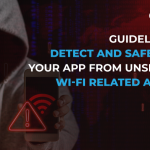
Increased Threat Perception in 2023 and Ways to Counter Attack in 2024
In 2024, mobile apps are everywhere, shaping how we interact online, do business, and manage personal data. But along with their growth comes increased risks. Last year, security breaches soared, from data leaks to ransomware attacks, especially with more people working from home or in hybrid setups.
This report explores the rising threats to mobile apps in 2023 and 2024. It dives deep into the vulnerabilities and tactics cybercriminals use, backed by current data. It shows how mobile threats evolve alongside technology.
-
In 2023, the global app downloads reached 257 billion downloads. (Source)
-
$362 Billion is the amount businesses and marketers spent in 2023 to promote their mobile apps. Showing an 8% YoY growth. (Source)
-
iOS non-gaming installs grew by 7%. (Source)
-
In-app purchase revenue in non-gaming and gaming up by 19% and 11%, respectively. (Source)
Emerging Ploys & Threats in Mobile App Security
In the dynamic landscape of application security, hackers are constantly refining their tactics to bypass traditional defenses and exploit vulnerabilities. From leveraging artificial intelligence and machine learning to orchestrating sophisticated social engineering campaigns, the arsenal of hacker strategies is evolving rapidly. In this ever-changing environment, it’s imperative for organizations to stay ahead of the curve by understanding these new threats and implementing proactive security measures. Let’s delve into the realm of modern hacker strategies and uncover effective ways to mitigate their impact on digital assets and infrastructure.
2023: A Roller Coaster of Offensive Hacking Innovation
The transition to remote and hybrid work cultures has reshaped the cybersecurity landscape, offering both opportunities and challenges for hackers. The widespread adoption of remote work technologies has provided hackers with new avenues for exploitation, targeting vulnerabilities in home Wi-Fi networks, personal devices, and lax security practices. The blurred boundaries between personal and professional devices increase the risk of phishing attacks and malware infections among remote workers, who often operate beyond corporate security perimeters. Hybrid work environments, blending remote and in-office work, further complicate cybersecurity efforts
-
26,000+ New vulnerabilities were published in 2023.(Source)
-
84% Singapore ranks highest of all ransomware attacks.(Source)
-
Healthcare breach costs have increased 53.3 percent to $10.93 million (Source)
-
61% Breaches involved in small businesses.(Source)
The Most Important Question: How to Thwart Hackers?
As miscreants increasingly target mobile applications, organizations need to stay alert to avoid breaches. While preventing every attack may not be possible, companies can follow these best practices to reduce their risks:
Secure code
Mobile apps often fall prey to reverse-engineering attacks. Miscreants reverse-engineer applications to study their operating logic, find loopholes to exploit them, and extract sensitive data. Writing a strong, tamper-proof code helps avert such attacks.
Encrypted data:
Every tiny bit of the data that is relayed between apps or servers must be encrypted. Encrypting data ensures that there are no leaks during data storage and transmission. Even if encrypted data gets leaked, it does not make any sense to miscreants.
Secure libraries:
Developers should be extra cautious while using third-party libraries, since they have no control over the strength of these codebases. They should make sure the codes are verified through peer networks & integration codes are also tested properly. They should update the library codebase as soon as it is released, as it fixes most recent vulnerabilities.
Careful use of APIs:
Developers must use only authorized third-party APIs to avoid inadvertently granting advanced user privileges to miscreants. The best practice is to authorize APIs centrally to maintain high-security protocols.
Strong authentication:
Most security breaches take place because of weak authentication. Weak passwords are the lowest hanging fruits for any potential attacker who wants to breach an organization’s defense system and exploit it. Developers need to design a mechanism that accepts only strong alphanumeric passwords that need to be updated at least once in six months.
Runtime Application Self Protection – How will it secure apps from known and unknown threats?
The runtime application self-protection (RASP) feature helps Android, Hybrid and iOS apps shield themselves against analysis during runtime and live attacks. The AppSealing security layer integrates the RASP feature with apps and allows developers to monitor their apps in real time on its cloud-based dashboard. Once a threat is detected, the AppSealing security layer can send a notification to the app user to end the session or warn the developer on the dashboard about its potential harmful effects. The AppSealing layer can also terminate the app activity without requiring user intervention when it detects a serious breach. The AppSealing RASP feature also facilitates a safe communication path between the app and its server.
Course of action to Protect your Apps
It literally takes minutes to add scalable security to Android, iOS & Hybrid apps that too without any coding
PROTECT
Cover your code and Memory in a Security Layer
Encrypt the source code of your app with the highest level of encryption complexity, which frustrates hackers continuously. Let the AppSealing protection layer protect your appcode like it does in millions of other devices without any extra burden on server or device resources. Protect apps with obfuscation and mathematical transformation of app keys and data even in apps running in untrusted environments. Solve memory residue issues at app loading with memory cleaning and pre-empt attacks with RASP.
DETECT
Observe Tampering and Manipulation Attempts in Real Time
Detect multiple attack vectors on your app resources & user data with the help of an elaborate, analytics-driven AppSealing dashboard. Spot rooted devices for compromised security, emulation attempts for reverse-engineering efforts, dynamic modification queries, payment crack attempts, & the use of network-sniffing tools all in one place. Reduce go-to-market time to release secured mobile apps to end users.
RESPOND
Attack Hackers before They Do
Be ready with AppSealing’s most updated tools to spot and prevent hacking attempts through existing and emerging threats. Use its up-to-date database of threats to guard your app. Access its alert and notification system to be on top of security threats even before they can get to your code. Force complete termination of the app using the AppSealing security layer when a serious threat is detected.
AppSealing Advantage –
Standout Features
How mobile apps across sectors use AppSealing to protect code and Pll and repel attacks around known and emerging vulnerabilities
ZERO CODING REQUIRED
Mobile App security solutions are generally given least priority by Android & iOS app developers. With our ZERO coding Feature, you can now focus on coding & LET US handle the security.
THREAT ANALYTICS ON ATTACK VECTORS
AppSealing Developer Console (ADC) provides snapshots of all hacking attempts on the app and helps you make decisions based on data.
RUNTIME APPLICATION SELF PROTECTION (RASP)
Real-time source code protection, App Integrity protection, Anti-debugging, Network packet sniffing/spoofing tool detection & cheat tools.
COMPATIBLE WITH A THIRD-PARTY LIBRARY
Easy to use compatibility with third-party tools Jenkins, TeamCity, Crashlytics. Secure your apps directly through these tools & services.
About AppSealing –
AppSealing is a trusted player in the world of mobile application security. In today’s application-focused world, security should not slow down your speed of development. We utilize runtime application self-protection features to build scalable security solutions for your mobile apps business in quick time without “ANY CODING”. Our powerful security suite ensures real-time in-depth application security like source code protection, anti-reverse engineering, cheat tool & emulator detection/blocking, and enforces app integrity. It protects 800+ mobile apps and 800 million+ devices, successfully blocking 70 million+ threats across the globe. Our esteemed clientele spans across Gaming, Fintech, Movie apps, E-comm, Healthcare, and O20.





